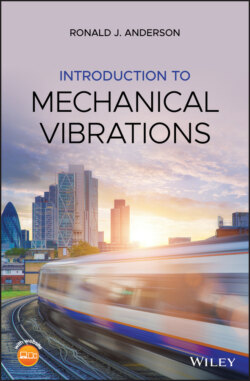Читать книгу Introduction to Mechanical Vibrations - Ronald J. Anderson - Страница 30
Exercises
Оглавление1 1.1 The figure shows an undeflected, nonlinear spring on the left and the same spring, now deflected by the weight of the hanging mass, on the right. Taking the coordinate, , as the deflection of the spring from its free length, the force in the spring can be expressed aswhere is in Newtons and is in meters.Figure E1.1What will be the equilibrium value of for a mass of 1200 kg?What is the effective stiffness of the system for small motions around the equilibrium in part (a)?Plot the force versus deflection curve for the element. Show the operating point and the linear approximation to be used in the equation of motion.
2 1.2 The figure shows the force/deflection characteristic for hardening springs used to support a large machine in a factory. The force (F in Newtons) written as a function of deflection (x in mm) isFour mounts of this type are placed under the four corners of the machine and deflect 3 mm as they take up the weight.Figure E1.2What effective stiffness does the system have about equilibrium?What is the mass of the machine?
3 1.3 The effective stiffness of any object that deflects under the action of a force can be expressed as the ratio of that force divided by the resulting deflection. In some cases, there are good theoretical expressions that can be used to get the effective stiffness. A good example is the effective stiffness of a uniform beam. Suppose you have two identical lightweight, uniform beams of length and flexural rigidity . One of the beams is cantilevered and the other is simply supported. You have a choice of supporting a heavy piece of equipment at the end of the cantilevered beam or at the center of the simply supported beam. Which support has a greater effective stiffness? What is the ratio of the two effective stiffnesses?
4 1.4 An open cylindrical container with a weight at its bottom is placed in the ocean. The cylinder sinks until buoyancy forces equal the total weight and then floats upright in equilibrium.Draw a FBD of the cylinder just after it is placed in the water. Use a DOF, , to indicate the distance the bottom of the cylinder has traveled below the free surface of the water. There will be a buoyancy force acting upward on the cylinder. This force is due to the water pressure a distance under the surface. That pressure is equal to where is the density of water and is the acceleration due to gravity. Assume a cross‐sectional area of for the cylinder.Use Newton's Laws to write the equation of motion for the cylinder.Find the equilibrium condition for the cylinder and solve for , the equilibrium value of .
5 1.5 The figure shows a cart of mass that is attached to the ground at point by a spring of stiffness and a damper with damping coefficient . The motion of the cart is forced by a harmonic motion at the end of another damper with coefficient .Write the equation of motion for the system using as the degree of freedom. Do this once using Newton's Laws and again using Lagrange's Equation and confirm that you get the same result from each method.Figure E1.5
6 1.6 The figure shows a thin, uniform rod with mass = and length = that has been released from rest where . The rod rotates about a frictionless pin at .Figure E1.6Write the nonlinear equation of motion for the rod using as the DOF.Derive the equilibrium condition.What are the two equilibrium values of ?Linearize the equation of motion about each of the equilibrium states and compare the two differential equations. The result should be two, linear, second‐order, homogeneous differential equations that differ only in the sign of the coefficient multiplying . This coefficient is the “stiffness” and having a negative stiffness makes an equilibrium state unstable. Does your unstable state make physical sense?
